Archive for the ‘kadath’ Tag

YOU STAND BEFORE A BLACK,& STRANGELY FORBODING DOORWAY AMID THE CHAOTIC RUINS OF THAT UNFATHOMABLE EVIL CITY OF THE ELDER ONES, THE DREAD – ‘YADDITH’.A CITY THAT DIED LONG BEFORE THE BIRTH OF MANKIND.
YOU & ONLY YOU,KNOW THE SECRET THAT WILL PREVENT THE RISE TO POWER ONCE AGAIN OF A FORCE SO DARK & EVIL,THAT TO DWELL UPON IT WILL SURELY BRING MADNESS
For those playing the home edition of our game Guess That Genre, yes, it’s our first — and what appears to be the very first — Lovecraftian horror game. The Commodore 64 port helpfully points out in the title screen this was originally written by Gary Musgrave in Altair Basic. (Altair, as in: the very first commercially successful “home computer”, more ancient than even the Apple 1. It seems appropriate for the game style.)
The C64 version also mentions the Altair version was written July 15th, 1979, and in 1981 it was ported to the Commodore PET by Robert Hennings before getting again converted for the C64.
So, naturally … I played the Exidy Sorcerer version instead. (Exidy Sorcerer as in: the computer introduced in 1978 and promptly abandoned by the manufacturer, with only a few die hard fans.)

Why? Well, the C64 version clearly had some scrunching for a 40 column version, whereas the Sorcerer (and the Altair) had more screen real estate to work with, so the Sorcerer port seems to be closer to the original Altair text.

A comparison: C64 on top, Sorcerer on bottom. Notice how the Dark Star’s name is lost in the C64 version. Also, some exclamation points. Those exclamation points surely are important to author intent.
Enough with the obscure computer parade: what is this like? In typical Lovecraftian fashion, you learn of a horror that must be stopped. In the words of the game, you must:
ENTER THE LABRYNTHIAN CAVERNS
FIND THE HIDDEN (& GUARDED) EYE OF KADATH
RETURN THE EYE TO ITS RIGHTFUL PLACE
INVOKE THE ELDER POWERS
DESTROY THE GATE THROUGH WHICH THIS UNIMAGINABLE EVIL WILL GAIN DOMINION
This game does not use a parser, but rather menus where you choose numbered options. However, unlike the simulation games of the era that used menus (Oregon Trail, Taipan, etc.) this sticks to an adventure game format with a map that allows backtracking and items and puzzles to solve.

Make the links clickable with a mouse, and you’ve got a Twine game.
The map design is so unusual I’m fairly sure it has never been used in any game before or since this one.

NUMBERING THEM CLOCKWISE FROM THE PASSAGE BY WHICH YOU ENTERED,PLEASE INDICATE WHETHER YOU WISH TO ENTER PASSAGE 1,2,3 OR 4?
You need to keep careful track of the clockwise numbering: if you enter, say, exit 1, and then go back, what was previously exit 2 is now exit 1, and what was previously exit 3 is now exit 2, etc. Laterally, this means the game mainly uses a pentagonal map system which makes me squee with delight a little. I love it when old games go for something completely off-center.

To illustrate further: when you start, the Cliff Overlook is at exit “1”, counting clockwise. If I went from Pentagon #2 to Pentagon #1 and wanted to go back to the Cliff Overlook, I would need to use exit “4” instead (since relatively speaking, it’s now the fourth room clockwise).
I don’t have a sense yet whether this will be a long game or a short game. The lengthy texts (for a home computer game) suggest this will necessarily be short, but the vagaries of a parser do take a lot of disk space, so it’s possible there’s a fair amount of game stuffed in here.
This was intended as part of my series on the 1979 game Kadath (aka the first Lovecraftian game ever made), but it got rather digressive, so I separated it out. I’ll tie some of these elements in on my next and last post on the game.
…
In a way, “interactive fiction” started before fiction was explicitly interactive. The mystery genre has always had an element of trying to predict who committed a crime before the ending is revealed. Ellery Queen (aka Frederic Dannay) appears to be the first person to explicitly cater to this tendency in The Roman Hat Mystery (1929).

A “branching narrative” where the reader can choose which direction the story flows came shortly after, in 1930, through the book Consider The Consequences! by Doris Webster and Mary Alden Hopkins.
Both these types of books — mysteries with explicit attempts to let the reader find the solution, and branching narratives — occurred intermittently through the 20th century. For the purposes of Kadath, we care more about the branching kind, so let me highlight a few more:
Treasure Hunt by Alan George (1945): “A MAZE in Volume Form – A Puzzle – A Picture-Story-Book – A Brain-Tonic – An Absorbing Pastime with Hours-and-Hours of Interest”
TutorText (1958-1972): A series teaching a wide assortment of topics interactively with titles like Trigonometry: A Practical Course, Understanding Shakespeare: Macbeth, and Understanding Stocks.
Un conte à votre façon (A Story as You Like It) by Raymond Queneau (1967): part of the French “Oulipo” group; a short story where your choices affect the parameters; you can try the English translation in interactive form here.

A diagram of Un conte à votre façon that was published with a collected volume of Oulipo’s work.
Lucky Les by E. W. Hildick (1967): “…by ingenuity and even more LUCK, Les survived in Miss Tabb’s boarding school where the pupils were fed on crusts and fried bootlaces! But what happened to him when he left school? Well, you can decide this for yourself.”
Sleep, and the City Trembles by Dennis Guerrier (“engineered by John Garforth”) (1969): He published three others the same year, including one where you could play solo Tic-Tac-Toe.

Via Amazon.
The twelve Tracker books (1972-1980): starting with Mission to Planet L and ending with Codebreaker International, with illustrations across every page of text …
… and I know I’m leaving a few out, but I hope the point is made that there was quite a bit out there before Edward Packer’s Sugarcane Island (written in 1969, finally published in 1976) which eventually led to the Choose Your Own Adventure series and a much, much larger audience.
Curiously, most of the people working above seemed to have come up with the branching idea independently. This was an invention that surfaced multiple times with different inspirations.
1. Doris Webster and Mary Alden Hopkins previously wrote “party game” books like I’ve Got Your Number! which finds the “key numbers” of party guests via personal questions. The idea of “personality traits adding up to a number” creatively evolved into a book with fictional characters where decisions go from number to number (and thus different story parts).
2. Treasure Hunt extends the general idea of puzzle books for children so that the narrative itself is a puzzle.
3. The TutorText series came from the ideas of teaching machines (Sidney L. Pressey, 1926), branching programming (Norman Crowder starting in the 1950s) and programmed learning (B.F. Skinner around the same time).
4. The French “Oulipo” group did all sorts of experiments with text where the goal was to find “new structures and patterns which may be used by writers in any way they enjoy”. Queneau in particular was interested in textual permutations, with a book of sonnets where the lines can be rearranged, and a single story told in 99 different ways.
5. E. W. Hildick seems to have segued off the idea of cats having “multiple lives”, and his book is subtitled “The Adventures of a Cat of Five Tales”.
6. Dennis Guerrier was apparently familiar with the actual TutorText books (and thus would be the first person inspired to write branching text via already existing branching text), but he turned the non-fiction overlay into fiction.
7. I’m least sure about the Tracker books. Weirdly, the covers emphasize “you” going on an adventure, but the text is in first person (of the books I was able to check).
8. For Edward Packer’s inspiration, I’ll quote directly from a secondary source (I assume this was pulled from an interview, but I haven’t been able to find the original).
Edward Packer created the series of books out of an exchange he had with his daughters. He used to tell them stories each night about a character named Pete. One day, he ran out of adventures to send Pete on and he asked his children what they thought Pete should encounter that night.
To summarize, choice narratives were invented at separate times and derived from: adult party games, children’s puzzle books, educational learning philosophy, French experiments in text, the “multiple lives” of cats, and in-person storytelling.
All the above is in regards to stories “without state”, where the reader goes from section to section without keeping track of an “inventory” or “statistics”. (Of course, adding a whole lot of sections can essentially simulate keeping state, which is how it’s possible to make a book that plays tic-tac-toe.) With the introduction of roleplaying games in the early 1970s, it was inevitable that someone would eventually write a solo RPG. The same year that Sugarcane Island was published (1976) saw the release of Buffalo Castle by Rick Loomis for the Tunnels & Trolls system:

From one of the first pages of Buffalo Castle.
Dungeons and Dragons was/is the titan of the RPG field, and the first D&D solo adventure entitled The Solo Dungeon came out two years later in 1978 (written by Richard Bartle of MUD1 fame).
It’s worth lingering an extra moment here with a comment from the introduction:
It will offer a number of choices from which you pick out what happens … it is, in effect, a manual computer programme such as those used in certain ‘Teach Yourself’ books.
Despite all the history above (including the fact the D&D people knew about the Tunnels and Trolls people), the book references the TutorText series as a model for how the game works. In a way, by 1978 the form of gamebooks was just getting started, even though they technically dated back to 1930; they kept getting re-invented anew.
The Choose Your Own Adventure series proper launched in 1979: that’s when, finally, they got popular and people starting referencing other gamebooks in making their own.
1979 is also when Kadath was released, and where we’ll finish our story next time.
This game ended up around 2 hours long; if you’re interested in trying it, the Commodore 64 version is fine (link to play online). As far as *if* you should play it — if the idea of playing the first gamebook-form computer game appeals to you, or playing the first Lovecraft game in any form, then yes, try it out.
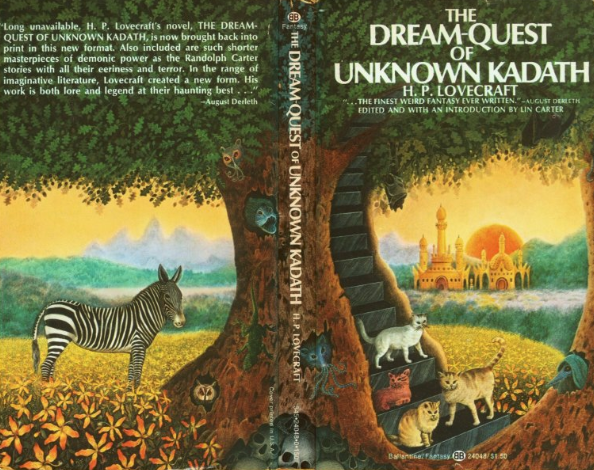
Cover via ISFDB; after this point are complete spoilers.
I. On the pentagonal map trick
Last time, I mentioned each main room of the game has five exits, and when you enter a room you specify where you go by a number (1, 2, 3, or 4) where the numbers represent the exits clockwise.
It worked for this game, but it wouldn’t work generally.
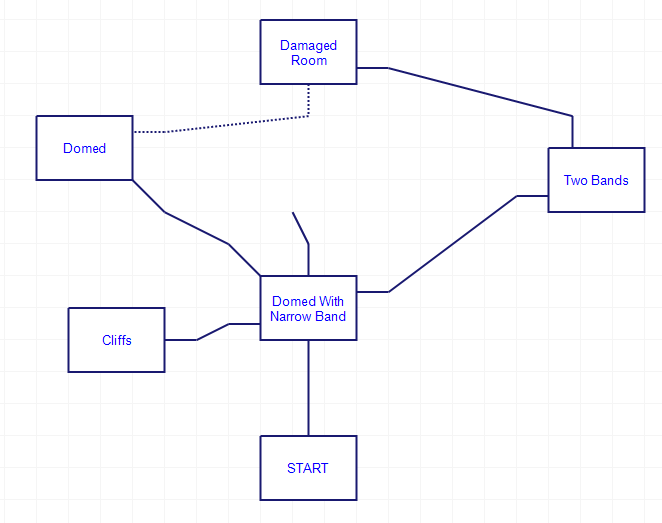
The map above is partial, but more or less represents my own game mid-play. I had mapped out the “Domed Narrow Band” room, “Two Bands” room, and “Domed” room. I just added the “Damaged” room and tried another exit, which brought me back to the “Domed” room.
But: where in the Domed room did I just arrive? There’s already a known connection (to the “Domed Narrow Band”) but I had no idea where the new passage is relative to the known one; that meant I couldn’t merge my new passage with what was there. In other words, the “known passage” could have been any number from 1 to 4. Figuring this out involved a lot of error and redraws of my map.
The author clearly knew his map was confusing and amplified the effect. You might go through a passage to a room and find there is a door to the left and a door to the right going back (that weren’t mentioned before) to find only one of them goes back to the original room … or even find *both* of them go back to the original room, but one of them is to a different exit (so the numbers 1 to 4 now correspond to entirely different places).

In fact, I’m fairly sure my current map is far off from the real one, so I’m not going to reproduce the whole thing here. It turns out the winning sequence is short so I just needed a sequence that worked, rather than thoroughly understanding how everything connected.
II. So far
The game gives “progress reports” at regular intervals, and one more report when you die.
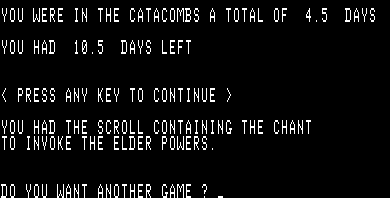
This was, in essence, akin to a “Story So Far” type update where a game gives you a running narrative of what’s happened so far if you restore a saved game file. (I most recently saw this in Heaven’s Vault, but it’s very rare in general.)
The reminder of days remaining serves to keep the tension up, and the mention of what items are found serves as fairly strong hints.
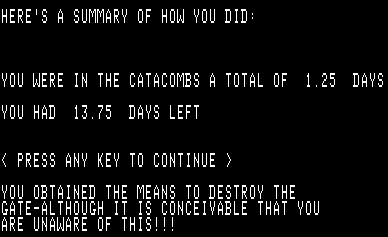
III. Instant death
There are no shortage of places to die. Some of them require you to actively take the final plunge.

Where could so many bones have possibly come from? Maybe I should get closer and check it out?
Some of them are a little more arbitrary.

I went the wrong direction.
IV. How inventory is handled
You’ll occasionally find an item; the game will either prompt if you want to take it with you, or in some cases if there’s more than one item, which one you want to take.
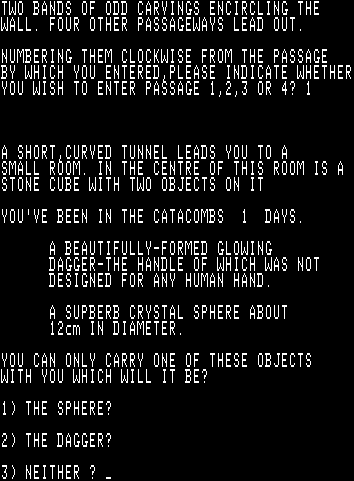
The “which item to take” complication keeps the puzzles from being too simplistic … but only barely. My first time through I had taken the sphere. Later I found an “AMORPHOUS BLOB” where my only option was to run away, and the game frets over my lack of a weapon. So … return to swap the sphere for the dagger, come back, and then I could use the dagger on the blob.

V. On winning
The start of the game states you need to
find and return the Eye of Kadath
invoke the Elder powers
destroy the Gate
The “story so far” bits helpfully fill in when you’re ready, so it’s just a matter of going to the right location and … typing?

This felt weirdly like a trivia quiz, but I suppose the effect was better than having everything done automatically. Having to type the chant was a nice touch, except my first time through I messed it up because my emulator’s apostrophe button was a different-than-usual key, causing the universe to be destroyed. (Little did we realize humanity’s fall would be due to keyboard mapping.)
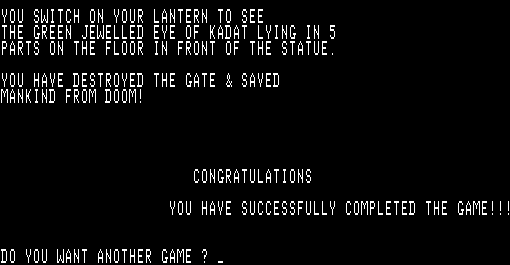
This game was just the right length to get across the Lovecraftian sense of dread and confusion without overstaying its visit.
VI. On the gamebook connection
My main question by the end was (and still is) “where did Gary Musgrave get the idea for this?”
While there are many gamebooks that came before, Kadath doesn’t resemble any of them that closely (and I hope the numerous re-inventions I mentioned in my short history attest to the fact it’d be possible to be writing in 1979 while still unaware of all of them). Primarily, the choice books before that point had each numbered section as a plot-point but not as a physical location in space, and the idea of returning to prior locations in loops would be doubly weird. If anything, he may have been familiar with the Tunnels and Trolls games, but even those emphasized forward progress and were more into RPG elements than puzzles.
In other words, this may have represented yet another re-invention of the gamebook form. Cave of Time (the first Choose-your-own-Adventure) wasn’t out until July of 1979, the same month this game was released. Could this have been made immediately after the author saw Cave of Time (assuming, of course, he saw it in the first place)? While possible, it seems too heavily morphed from the CYOA concept to be a rush job.
We have seen some menu-based adventure games: Treasure Hunt (1978), Quest (1978) and Mines (1979) all qualify. Even if Mr. Musgrave hadn’t played them, it wouldn’t be too complex a leap from menu-based adventure as a concept to a game with more active plot choices, attempted atmosphere writing, and choices involving an inventory.
There’s also some element of text simulation-narrative games, yet another genre I haven’t written much about. Compare the march of time to that of, say, Camel (link to play online).
You have travelled 0 miles altogether.
What is your command? 2
Your camel likes this pace.
You have travelled 9 miles altogether.
What is your command? 3
Your camel is burning across the desert sands.
———-W A R N I N G———- Get a drink
You have travelled 23 miles altogether.
Alternately, note how in early versions of Oregon Trail you have to type BANG correctly while hunting. Compare this to the ending of Kadath where you have to type the chant. (I never verified if the typing was timed, but the game did indicate you needed to hurry.)
Whatever the original source of creativity, I appreciated this game was rescued from the depths by being ported off the Altair. If you’re wondering when the first “straight CYOA game” for computer happened (that is, one designed specifically for computer that only goes from node to node, with no inventory or the like), we’ll need to return to 1980 and a famous disaster that killed over 50 people.




























